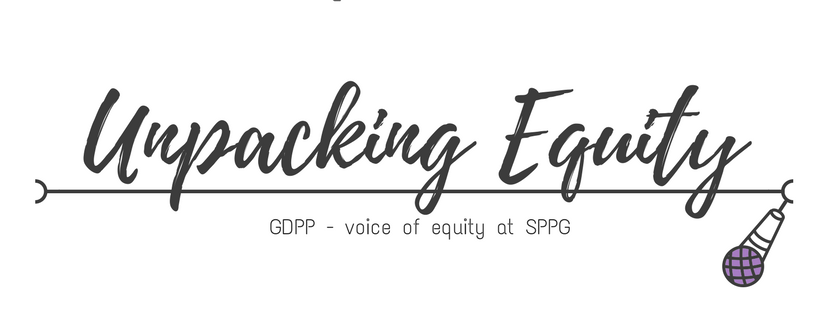
Unpacking Equity is a collaboration between the Public Policy and Governance Review and the Gender, Diversity and Public Policy Initiative (GDPP) at the School of Public Policy and Governance. This series aims to explain equity-related policy issues and break down complicated topics involving equity, diversity and inclusion. Policy professionals can gain a better understanding of these complex issues in order to incorporate an equity lens into their practice. To learn more, please get in touch with the GDPP.
—
Nora Yousefi
It has been nearly three decades since Kimberlé Crenshaw first introduced the term ‘intersectionality’ into the public lexicon. Since then its application in scholarship and activism has grown in popularity. Intersectionality explores the ways in which people of various identities distinctly experience oppression. Black feminist, Latina, queer, anti-colonial, and Indigenous scholarships have all used this concept to denote the different ways complex social processes shape the multiple dimensions of human experiences. Similarly, this approach has been extended to policy makers to better confront complex social issues.
What is intersectionality and how does it relate to policy?
Intersectionality is premised on three interrelated concepts. First, intersectionality theory acknowledges that human experiences are not a result of singular social characteristics (such as class, gender, sexuality, race/ethnicity, immigration status, Indigeneity, geographical location, age, ability and religion). Policy analysis cannot assume that any one category is enough to explain how people’s needs are shaped and affected by policy. Rather, intersectionality-based policy analysis is interested in revealing how intersections between these social characteristics (referred to as social locations) organize unique experiences. For example, intersectionality-based policy analysis will explore the intersections of gender and racial status when trying to create a policy that targets precarious workers. This is because racialized women are disproportionately represented in part-time, unstable labour.
Second, intersectionality theory asserts that social locations are grounded within a context of interconnected ruling systems and structures, including laws, policies, state institutions, popular rhetoric, the media, and interpersonal interactions. The problem emerges when these structures of power produce laws or policies to address individual social issues, in turn excluding those whose social locations are the result of intersecting social characteristics. For instance, Canadian policy makers agree that women should have access to timely and adequate maternal-care that allows them to make autonomous decisions to suit their particular needs. However, maternal-care policies often overlook the intersections of gender and Indigeneity. While these policies provide access to timely maternal-care for women living in high-resource, urban areas, Indigenous communities on reserves have restricted healthcare resources and limited medical centres that are unequipped to providing timely maternal-care.
Last, ruling institutions (such as policies) interact with informal hegemonic structures (such as imperialism, colonialism, racism, patriarchy, homophobia, and ableism) to shape unique forms of domination and subordination. For instance, historic anti-marriage fraud laws, embedded within immigration policy, required immigrant women to live with their spouses, who were sponsoring them, for a minimum of two years in order to gain permanent residency status. Women whose sponsors were violent and abusive, were reluctant to leave their batterer for fear of deportation. Ultimately, immigration policy interacted with patriarchal norms of aggression to produce vulnerable experiences of intimate partner violence against women.

Guiding Principles of Intersectionality
- Intersectionality understands experiences of discrimination to be larger than the sum of its parts by highlighting how each social category interacts with one another to create unique experiences of oppression.
- Disadvantage and privilege is formed across a variety of levels of institutions (such as micro/macro structures or through provincial and regional policies). Addressing inequities must be done in their respective institutional contexts. Intersectionality-based policy analysis reveals the relationship between social locations and levels of institutional structures.
- Power, which functions through discourse and institutions, organizes social categories to produce experiences of privilege and disadvantage. An individual can experience privilege from one social category (say race), while simultaneously being oppressed by another (say gender).
- Identities and social locations take on different values and meanings in different time and spatial contexts. Intersecting social categories are fluid, therefore an individual may experience subjugation in one region of the world, and not in another region of the world. Inequities experiences as a consequence of immigration is an important example of this principle.
The Call for Intersectionality in Policy
Researchers and policy makers must consider their own social position, role, and power when taking an intersectional approach. This self-awareness is referred to as ‘reflexivity’, and should take place before setting precedents and directions in policy work, in order to acknowledge predisposed notions of one’s social roles. Intersectionality is closely tied to notions of social justice and equity. While equity (not to be confused with equality and explained in depth here) is concerned with fairness, social justice efforts aim to produce equitable policy outcomes by addressing social issues at their root and transforming social structures. In sum, intersectionality is a tool for policy researchers to reveal and understand complex and contextual social issues, while serving as a guide for policy actors to set equitable priorities in policy work.
The definitions and guiding principles for intersectionality-based policy analysis used in this article are informed by Olena Hankivsky’s developments on intersectionality in policy.
Nora Yousefi is a Master of Public Policy candidate at the University of Toronto’s School of Public Policy and Governance, and holds a BHS in Health Studies with a specialization in Health Policy from York University. She is currently a social science researcher at the MA in Health Policy and Equity program at York University where she is exploring how policy shapes the health of Indigenous and immigrant women.
One Comment
Comments are closed.